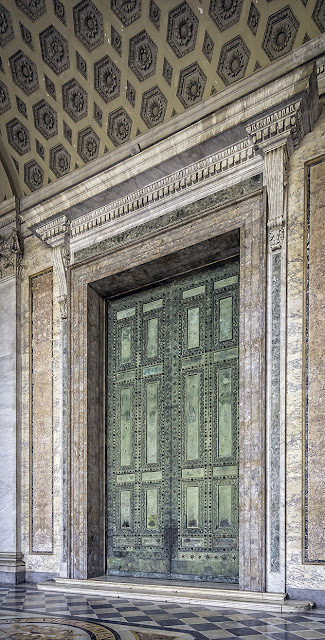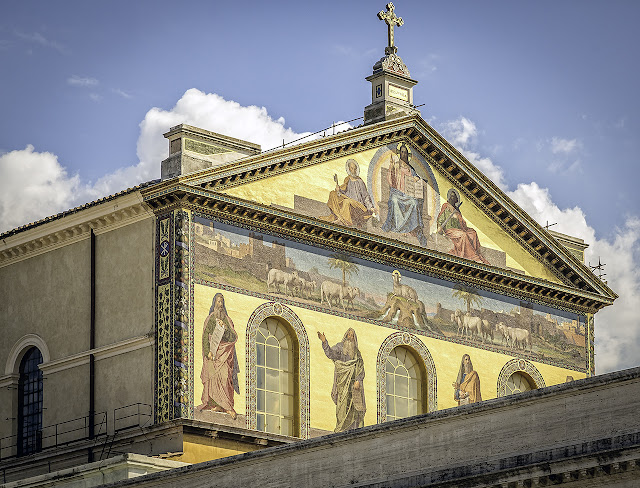The Papal Archbasilica of St. John in the Lateran (Italian: Arcibasilica Papale di San Giovanni in Laterano), commonly known as St. John Lateran Archbasilica, St. John Lateran Basilica, St. John Lateran, or just The Lateran Basilica, is the cathedral church of Rome and the official ecclesiastical seat of the Roman Pontiff. It is the oldest and ranks first among the five Papal Basilicas of the world and the four Major Basilicas of Rome (all of which are also Papal basilicas), being the oldest church in the West and having the Cathedra of the Bishop of Rome. It has the title of ecumenical mother church among Roman Catholics. The current archpriest is Agostino Vallini, Cardinal Vicar General for the Diocese of Rome. The President of the French Republic, currently François Hollande, is ex officio the "first and only honorary canon" of the Archbasilica, a title held by the heads of state of France since King Henry IV.
The large inscription on the façade reads in Latin: Clemens XII Pont Max Anno V Christo Salvatori In Hon SS Ioan Bapt et Evang; which a highly abbreviated inscription translated as "Pope Clement XII,
in the fifth year of his reign, dedicated this building to Christ the
Savior, in honor of Saints John the Baptist and John the Evangelist". This is because the Archbasilica, as indicated by its full title was originally dedicated to Christ the Savior, with the
co-dedications to the two St. Johns being made centuries later. As the
cathedral of the Bishop of Rome, it ranks above all other churches in
the Catholic Church, including St. Peter's Basilica. For that reason, unlike all other Catholic basilicas, it is titled Archbasilica.
This completed our trip to Italy and the last of the four major Basilicas of Rome.
Friday, October 3, 2014
Scala Sancta (Holy Stairs), Rome
The Scala Sancta (English: Holy Stairs, Italian: Scala Santa) are a set of 28 white marble steps located within a building in Rome near the Lateran Basilica and is an extraterritorial property of the Holy See. The steps, long encased in a protective framework of wooden steps, are located in a building that incorporates part of the old Lateran Palace. The stairs lead to the Sancta Sanctorum (English: Holy of Holies), the personal chapel of the early Popes known as the chapel of St. Lawrence. According to the Catholic tradition, they are the steps leading up to the praetorium of Pontius Pilate in Jerusalem on which Jesus Christ stepped on his way to trial during the events known as the Passion. The stairs were, reputedly, brought to Rome by St. Helena in the fourth century. For centuries, the Scala Sancta has attracted Christian pilgrims who wish to honor the Passion of Jesus.
The Scala Sancta are encased in protective wood and may only be ascended on the knees. For common use, the staircase is flanked by four additional staircases, two on each side, constructed around 1589. Climbing the Holy Stairs on one's knees is a devotion much in favor with pilgrims and the faithful. Several popes have performed the devotion.
Due to time constraints, we were unable to ascend the staircase during our tour.
The Scala Sancta are encased in protective wood and may only be ascended on the knees. For common use, the staircase is flanked by four additional staircases, two on each side, constructed around 1589. Climbing the Holy Stairs on one's knees is a devotion much in favor with pilgrims and the faithful. Several popes have performed the devotion.
Due to time constraints, we were unable to ascend the staircase during our tour.
St. Paul Outside the Walls, Rome
The Papal Basilica of St. Paul outside the Walls (Italian: Basilica Papale di San Paolo fuori le Mura), commonly known as St. Paul's outside the Walls, is one of Rome's four ancient, Papal, major basilicas, along with the Basilicas of St. John in the Lateran, St. Peter's, and St. Mary Major.
The Basilica is within Italian territory and not the territory of the Vatican City State. However, the Holy See fully owns the Basilica, and Italy is legally obligated to recognize its full ownership thereof and to concede to it "the immunity granted by International Law to the headquarters of the diplomatic agents of foreign States."
According to tradition, St. Paul's body was buried two miles away from the place of his martyrdom, in the sepulchral area along the Ostiense Way, which was owned by a Christian woman named Lucina. A tropaeum was erected on it and quickly became a place of veneration. Constantine I erected a basilica on the tropaeum's site, and the basilica was significantly extended by Theodosius I from 386, into what is now known as Saint Paul Outside the Walls.
The covered portico that precedes the façade is a Neo-classicist addition of the 19th-century reconstruction. The 20th-century door includes the remains of the leaves from the original portal, with scenes from the New and Old Testament. On the right is the Holy Door, which is opened only during the Jubilees.
The new basilica has maintained the original structure with one nave and four aisles. It is 131.66 metres (432.0 ft) long, 65 metres (213 ft)-wide, and 29.70 metres (97.4 ft)-high, the second largest in Rome.
The nave's 80 columns and its stucco-decorated ceiling are from the 19th century. All that remains of the ancient basilica are the interior portion of the apse with the triumphal arch.
In the old basilica each pope had his portrait in a frieze extending above the columns separating the four aisles and naves. A 19th-century version can be seen now. The nave's interior walls were also redecorated with scenes from Saint Paul's life in two mosaics.
The following photos show the exterior and interior of St. Paul Outside the Wall. This was our last afternoon in Rome with upcoming stops at Scala Santa (The Holy Stairs) and the Basilica of St. John Latern, the final major basilica of Rome.
The Basilica is within Italian territory and not the territory of the Vatican City State. However, the Holy See fully owns the Basilica, and Italy is legally obligated to recognize its full ownership thereof and to concede to it "the immunity granted by International Law to the headquarters of the diplomatic agents of foreign States."
According to tradition, St. Paul's body was buried two miles away from the place of his martyrdom, in the sepulchral area along the Ostiense Way, which was owned by a Christian woman named Lucina. A tropaeum was erected on it and quickly became a place of veneration. Constantine I erected a basilica on the tropaeum's site, and the basilica was significantly extended by Theodosius I from 386, into what is now known as Saint Paul Outside the Walls.
The covered portico that precedes the façade is a Neo-classicist addition of the 19th-century reconstruction. The 20th-century door includes the remains of the leaves from the original portal, with scenes from the New and Old Testament. On the right is the Holy Door, which is opened only during the Jubilees.
The new basilica has maintained the original structure with one nave and four aisles. It is 131.66 metres (432.0 ft) long, 65 metres (213 ft)-wide, and 29.70 metres (97.4 ft)-high, the second largest in Rome.
The nave's 80 columns and its stucco-decorated ceiling are from the 19th century. All that remains of the ancient basilica are the interior portion of the apse with the triumphal arch.
In the old basilica each pope had his portrait in a frieze extending above the columns separating the four aisles and naves. A 19th-century version can be seen now. The nave's interior walls were also redecorated with scenes from Saint Paul's life in two mosaics.
The following photos show the exterior and interior of St. Paul Outside the Wall. This was our last afternoon in Rome with upcoming stops at Scala Santa (The Holy Stairs) and the Basilica of St. John Latern, the final major basilica of Rome.
Father Mike looking for stragglers among the group so we can be on our way to St. Paul Outside the Walls...
Subscribe to:
Posts (Atom)




























































